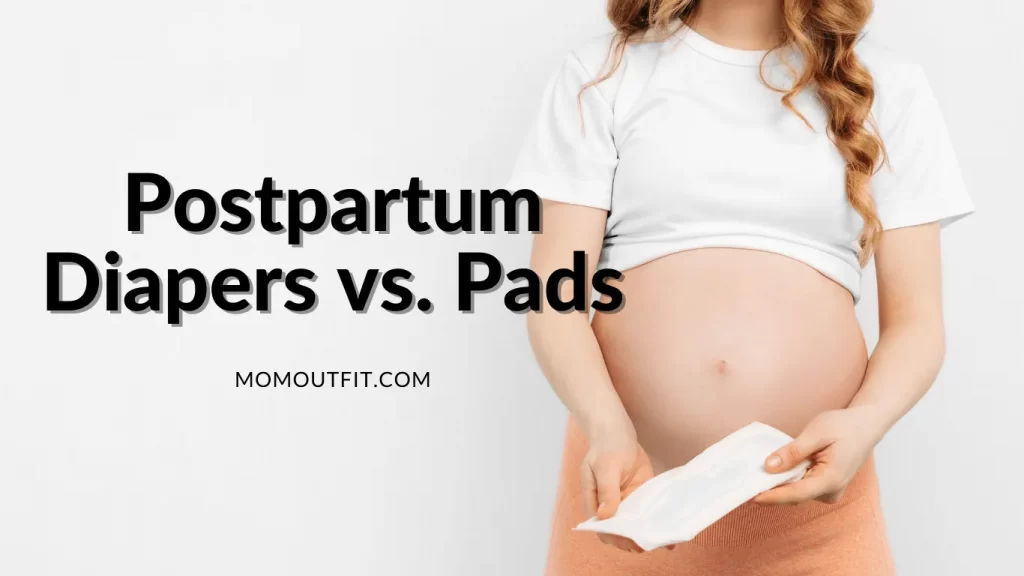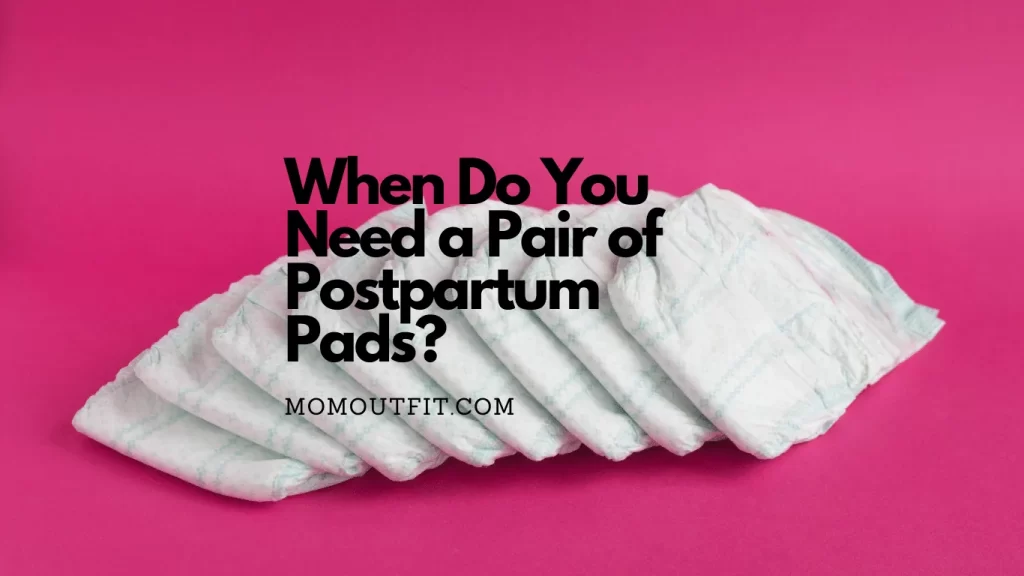Introduction to Postpartum Diapers vs. Pads, Their Differences, and Benefits
After you’ve had a baby, you’ll likely need to use some form of postpartum protection. It could be in the form of diapers, pads, or even special postpartum underwear. So, what’s the difference between these products? And more essentially, which one is right for you?
Postpartum diapers are designed to offer maximum absorbency for post-pregnancy bleeding. They usually have a wide, leakproof back and sides, and many also have a waterproof outer layer. It makes them ideal for use during the heaviest days of postpartum bleeding.
Postpartum pads, on the other hand, are thinner and have a more absorbent core. They’re designed to be worn inside your regular underwear and are often used during the lighter days of postpartum bleeding.
Both maternity diapers and pads have their advantages and disadvantages. Postpartum diapers offer more protection against leaks but can be bulky and uncomfortable. Maternity pads are less bulky and more comfortable but don’t offer as much protection against leaks.
In this blog, I share some detailed information about these two essential post-pregnancy wear. I hope you’ll love the postpartum diapers vs. pads discussion.

Definitions of Postpartum diapers and pads
What are Postpartum Diapers?
Postpartum diapers or period underwear are diapers specifically designed to be worn by mothers during the postpartum period. They are typically larger and more absorbent than regular diapers. They may also feature special features such as leakproof technology and extra support for the abdomen.
What are Postpartum Pads?
Postpartum pads are pads that mothers wear after giving birth. They help absorb any blood or other fluids you may release during the postpartum period.
Are Pads a Diaper?
No, pads and diapers are not the same thing. They are both absorbent hygiene products, but they are designed for different purposes.
Diapers are typically worn by babies and toddlers to absorb urine and feces. They are usually made of a waterproof outer layer, an absorbent inner layer, and fasteners to keep them in place.
Pads, on the other hand, are worn by menstruating people to absorb menstrual blood. They come in a variety of shapes and sizes, and they are typically attached to underwear with adhesive strips.
What are the Different Types of Postpartum Diapers?
Many types of postpartum diapers are available on the market today. Choosing the perfect item for you can be overwhelming. Here I am adding a breakdown of the different types of postpartum diapers to help you make the best decision for your needs.
1. Disposable Postpartum Diapers
Disposable postpartum diapers are the most popular type of diaper used by new moms. They are convenient and easy to use. Simply put them on and throw them away when you’re done. They are also the most expensive type of adult diapers.
2. Cloth Postpartum Diapers
Organic cotton or cloth postpartum diapers are a more natural and eco-friendly option. They are also less expensive than disposables. However, they require more work to use and wash.
3. Hybrid Postpartum Diapers
Hybrid postpartum diapers are a combination of cloth and disposable. They have a cloth outer layer and a disposable inner layer. They are more expensive than cloth diapers but less expensive than disposables.
4. All-in-One Postpartum Diapers
All-in-one postpartum diapers are similar to disposable diapers, but they are made of cloth. They are more expensive than disposables but less expensive than cloth diapers.
5. Training Postpartum Diapers
Training postpartum diapers are designed to be used during the potty-training process. They are more expensive than other diapers, but you can reuse them.
No matter what type of postpartum diaper you choose, the most important thing is that you and your baby are comfortable.
What are the Different Types of Pregnancy Pads?
If you’re a new mom, you’re probably wondering what kind of postpartum pads you should use. Here’s a list of different types of postpartum pads to help you make the best decision for you and your baby.
1. Disposable pads
Disposable postpartum pads are the most popular choice for new moms. They’re convenient and easy to use, and you can throw them away when you’re done.
2. Reusable postpartum recovery pads
Reusable postpartum pads are a great eco-friendly option. You can wash and reuse them, which saves money in the long run.
3. Cloth maternity pads
Cloth postpartum pads are another eco-friendly option. They’re also less expensive than disposable or reusable pads.
4. Diaper-style postpartum pads
Diaper-style postpartum pads are similar to disposable diapers. They’re absorbent and can be thrown away when you have used them.
5. Pantyliners
Panty liners are a good option if you want a little protection. They’re not as absorbent as other postpartum pads, but they’re more comfortable for some women.
You can now pick the best one as you know it well. Choose the type of pad that can be most comfortable for you and offer the best protection.
How do Different Types of Pads and Diapers Work?
There are so many different types of pads and diapers on the market, and you may find it difficult. Here’s a quick explanation of the most popular types of pads and diapers and how they work:
Postpartum Discreet Underwear:
These special types of underwear are designed to hold a pad and usually have extra support to help control leaks. They can be a godsend for new moms, who often find themselves leaky and exhausted.
Postpartum Diapers:
These are similar to regular diapers but are designed to fit a woman’s post-birth body. They usually have extra absorbency; some even have a waterproof layer to prevent leaks.
Pads vs. Diapers:
Pads are typically thinner than diapers and are meant to absorb menstrual flow. Adult diapers are thicker and more absorbent and are meant for urinary incontinence or bowel incontinence.
Menstrual Pads:
You can find two main types of menstrual pads: disposable and reusable. Disposable pads are the most popular and are made with absorbent materials like cotton. You can find reusable pads made of cloth that can be washed and reused.
Cloth Pads:
Cloth pads are an eco-friendly and economical alternative to disposable pads. They’re made of absorbent materials like cotton and can be washed and reused.
Is There a Difference Between Postpartum Diapers and Pads?
There is considerable debate among new moms about whether to use diapers or pads after giving birth. Some say that diapers are more comfortable and offer better protection. In contrast, others find that pads are less bulky and easier to deal with. So, what’s the truth? Is there a difference between postpartum diapers and pads?
Here’s a breakdown of the pros and cons of each:
Pads:
Pros
- Less bulky and more accessible to deal with than diapers
- Pads are less expensive than diapers.
- Pads are more comfortable than diapers.
- Pads are more absorbent than diapers.
Cons:
- Can leak more easily than diapers
- Pads can be inconvenient to change.
- Pads can cause skin irritation.
Diapers:
Pros:
- More comfortable and offer better protection against leaks
- You can wear diapers for a more extended time than pads.
- Diapers are less likely to leak than pads.
Cons:
- They can be bulkier and more difficult to deal with than pads
- Diapers are more expensive than pads.
- Diapers can be uncomfortable.
- Diapers can cause skin irritation.
So, which one is best for postpartum? Ultimately, it comes down to personal preference.
Some women find that diapers are more comfortable and offer better protection. In contrast, others find that pads are less bulky and easier to deal with.
How long do you wear diapers after the birth of your child?
There is no set or exact time frame for how long a person should wear diapers after the birth of their child. Generally, experts suggest wearing them for at least the first few weeks after childbirth to help heal.
When Do You Need a Pair of Postpartum Pads?
Like most new moms, you’re probably wondering when you’ll need a pair of postpartum pads. But why do moms wear diapers after birth, do you know?
Here’s a quick rundown of when you might need them:
- If you’re experiencing leaks from your bladder, you’ll need a pad to protect your clothing.
- If bleeding heavily after childbirth, you’ll need a pad to absorb the blood and protect your clothing.
- If you’re leaking breast milk, you’ll need a pad to protect your clothing.
- If you’re experiencing vaginal discharge, you’ll need a pad to absorb and protect your clothing.
So, there you have it! Grab a pair of organic postpartum pads if you’re experiencing any of the above.

What are Some Benefits and Disadvantages of Using Pads after Birth?
Advantages
There are many advantages to using pads after you give birth. For one, pads can help to keep you clean and dry. They can also help to prevent infection. Additionally, pads can help to reduce the amount of blood loss. Finally, pads can provide comfort and support to your body during the postpartum period.
After giving birth, many women find that pads are much more comfortable than tampons. Here are some advantages of using pads:
1. Pads are more absorbent than tampons so they can provide better protection against leaks.
2. Pads are less likely to cause irritation or discomfort than tampons.
3. Pads are easy to use and don’t require any special inserting. A pad is much simpler than inserting a tampon, and you don’t have to worry about getting stuck or lost inside your body.
4. Pads are more affordable than tampons.
5. You can wear a pad for as long as you need to, without worrying about changing it every few hours as you would with a tampon.
If you’re considering using pads after birth, talk to your doctor or midwife first to ensure they’re the right choice.
Disadvantages
Giving birth is a unique, life-changing event. But it can also come with some not-so-amazing side effects – like bleeding. For the first few weeks post-birth, most women will experience what’s called lochia. Lochia is a vaginal discharge that can range from light spotting to heavier bleeding, lasting any duration; from couple of days to several weeks.
For many women, pads are the go-to method for dealing with lochia. But there are some disadvantages to using pads that are worth considering.
1. Pads can be uncomfortable.
Wearing a pad for an extended period can be uncomfortable, especially if you’re already dealing with postpartum discomfort. If you’re finding that pads are uncomfortable, you might want to try using a menstrual cup instead.
2. Pads can cause chafing.
If you’re already dealing with sensitive skin post-birth, the last thing you want is to add to that discomfort with chafing from your pads. If you’re using pads, be sure to choose ones made with breathable, comfortable material. And consider changing your pads more frequently to reduce the risk of chafing.
3. Pads can be a breeding ground for bacteria.
Because pads are in contact with your body for extended periods, they can become a breeding ground for bacteria. If you’re using pads, change them frequently and practice good hygiene to reduce the risk of infection.
4. Pads can leak.
Pads can leak, especially if you’re bleeding heavily. If you’re concerned about leaks, you might want to try using a menstrual cup or a pad with a leakproof liner.
5. Pads can be expensive.
If you’re on a budget, pads can be a significant expense. Menstrual cups and other alternatives to pads can be more cost-effective options.
Considering using pads after birth, weigh the pros and cons to decide what’s best for you.
Conclusion
Ultimately, the best postpartum protection for you is the one you feel most comfortable with. If you’re worried about leaks, the best postpartum diapers for c-section may be the best option. If you’re more concerned about comfort, wear postpartum pads that may be a better choice.
Thanks for reading the postpartum diaper vs. pad blog. Please, don’t forget to leave a comment to inspire me to write more on it.

Born in Texas, Jennifer loves to spend time with her kids. Often, she shares her thoughts from the experience of being a mother. She focuses on surprising the Momoutfit readers with incredible information. Her vision is being a better mother, a visionary person.
